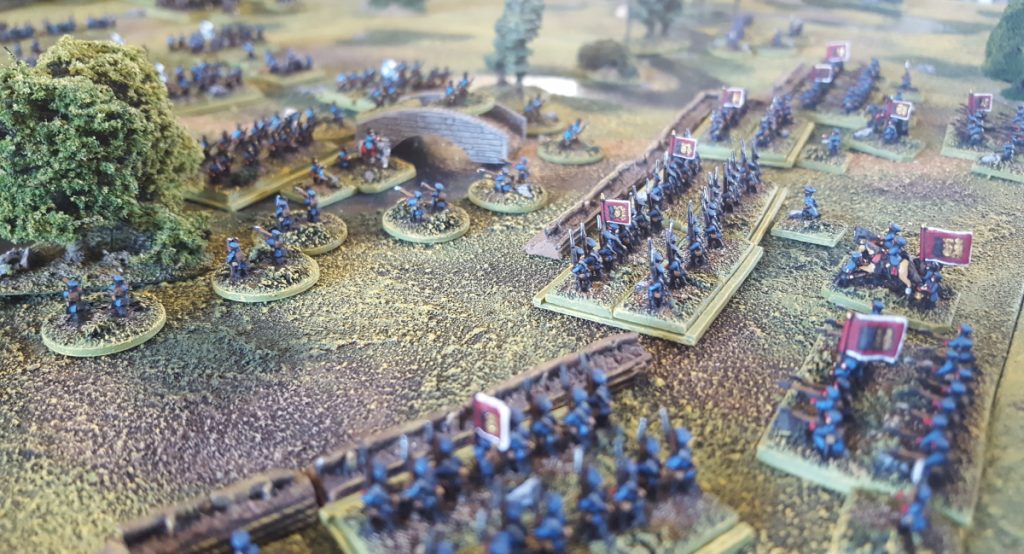Not a real conflict obviously, but a fictitious one I’m intending to fight using my mid-19th century 6mm armies. This is a follow-on to the approach I described here: https://themedetianwars.org.uk/2019/08/6mm-19th-century-battles.html
Most games will be played solo, but hopefully I’ll be able to have the occasional guest appearance by a visiting general. Most of the forces are painted and ready, and where they’re not they will be fed into the campaign as they become available. I’ll describe force compositions, and the lightweight campaign rules I’m using, as I go.
The situation at the point where diplomacy (what little there had been) failed:

The map is an extract from the superb Murat collection, used with kind permission from their creator Malcolm McCallum. This point-to-point mapping has towns one day’s march apart, and national borders in pink. I am representing each infantry or cavalry division, and each Corps reserve, with a map counter. Occasionally smaller detachments, generally representing a brigade, will be be marked with just a simpler national flag.
Background and the lead-up to war.
With war in the Crimea being narrowly averted the year before, the Great Powers are free to turn their attention to other matters and, somewhat inevitably, diplomatic strife soon rears its head elsewhere. Several of the Southern states of Germany, growing increasingly uncomfortable with the domineering approach of the German Confederation, decide to resign their membership. Unwilling to accept this disruption and the dangerous precedent it sets, the recently re-established Confederation decides to force the rebellious states back into line. Prussia, Austria and Bavaria assemble forces and prepare to invade Baden and Wurttemburg and Hesse-Darmstadt. These states invoke their secret mutual defence pact with France and mobilise to defend their borders. Despite prevarication and calls to seek a peaceful outcome, Britain reluctantly decides to support France when it becomes clear that the German aggression represents a significant threat to the continental order.
Therefore, as the campaign begins the opposing sides are composed as follows;
- The French-led Alliance, comprising Baden, Wurttemburg, Hesse Darmstadt and Britain
- The German Confederation comprising the forces of Prussia, Austria and Bavaria
The defending forces must hold on against more numerous attackers, while allies march to their assistance. The campaign opens with frontier clashes as the invading German armies attempt to co-ordinate their movements against a number of smaller forces defending their own lands.
Forces of the Confederation
Austria
As the most influential member of the Confederation, Austria sees any reduction in its membership as a sign of her own decreasing authority, and therefore as a direct challenge. In response, the Emperor has sent a powerful contingent of two full army Korps as well as 2 independent cavalry divisions; a total of 51,400 men. Marching piecemeal from all across the Empire, the Austrians are slowly assembling in Lindau close to the Wurttemburg border.
Prussia
Concerned about Russia’s intentions, Prussia is unwilling to dispatch the majority of its army to the west. However, Prussian forces still comprise two powerful formations, each totalling 25,700 men made up of an Army Korps and a cavalry division. These formations are gathering at the fortresses of Frankfurt and Wurzburg respectively, from where they will be ideally placed to invade the rebel states.
Bavaria
Although the junior partner, Bavaria is eager to make a good showing and has deployed a considerable proportion of her strength. A full Korps, accompanied by a cavalry division, together comprise a total of 24,200 men. Bavaria’s army is assembling at Augsburg, close to the Wurttemberg border but behind the Danube, from which it will have the option of several invasion routes while its flank is protected by the fortress city of Ulm.
Forces of the Alliance
France
With war about to erupt on her doorstep, France has strengthened her border forces and assembled a substantial army. It comprises two full Corps plus two cavalry divisions and one division each of infantry and cavalry from the recently re-established Imperial Guard, for a total of 66,000 men.
Baden, Wurttemberg, Hesse-Darmstadt
In defence of their homelands, these small German states have raised what forces they can, resulting in each being able to put into the field a division of 12,000 men. Baden’s troops are assembling in Karlsruhe, Wurttemberg’s in Stuttgart and Hesse-Darmstadt’s in Mainz.
British
With her traditional priority being command of the sea, Britain has committed only a modest force to this continental campaign. A single division of 12,000 men has been shipped to France and set off on its march to the Rhine. Uncharacteristically, it has been well-planned and executed, resulting in the British force reaching Stuttgart ahead of its anticipated arrival.
So, that’s the situation as hostilities commence.
Next post – Bavaria Attacks! Unwilling to wait for his allies, Maximillian II attempts to grab the glory by a precipitous invasion of Wurttemburg…


This looks like it will be most excellent and look forward to following your progress. And as ever I’m sure it will all look outstanding!
Thanks Andy, it will hopefully get me playing some games and it will be good to get back to blogging again a bit. Dave
So Andy says “have you seen Dave’s Blog?”, and I think, ‘oops, I haven’t been there in months’.
WTF Dave? Awesome. You’re a genius.
Cheers, let’s hope I can keep up some momentum then! 🙂
Interesting idea Dave. the map looks quality and its great to see some decent 6mm figures on display.
Thanks Robbie, they’re great maps and I’ve been intending to make use of them for some time. I knocked up the ‘counters’ in Excel. I hope to get the first battle posted up soon. Cheers, Dave